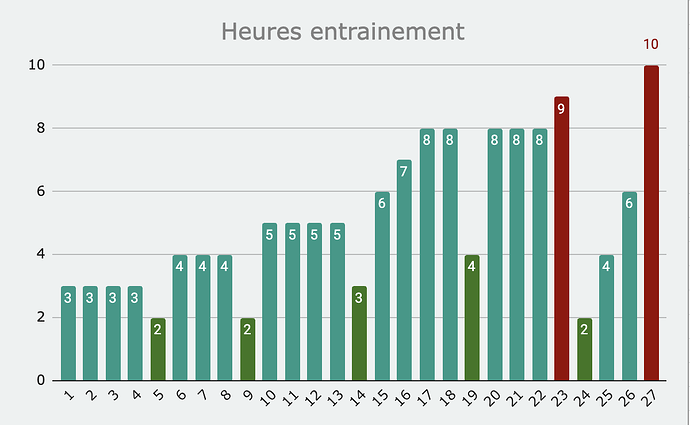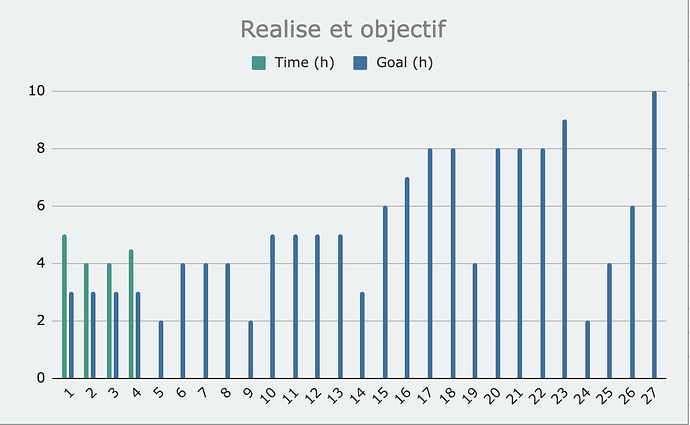Thanks for your opinion. Here is the plan I laid out: Starting from the date of the event and working backward to the start of the year. The chart is the number of hours targetted per week.
I am doing 4 weeks blocks (except one because of other constraints).
The goal is to increase time and spend 5 weeks prior to a B race on 8 hours a week.
And then going to the A race I mentionned before I should have accumulated 6-7 weeks of 8 hours a week training. I am not sure how much volume I will put in between the two races. This will depend on how I felt during the B race (week 23) and if I need recovery or not. The races are weeks 23 and 27 (the red bars). The green ones are recovery weeks.
You were suggesting 10 weeks of 7-8 hours volume. That will be a bit less giving there will be some recovery weeks in the middle. But that’s already a pretty challenging plan I believe for a first year of training. Reviews of my plan are welcomed 
Here is how it’s going so far:
@Tommy_Bal @MedTechCD regarding race speed:
Interesting inputs thanks a lot !! I also thought about the VAM metric as it is the metric I use in ski touring mostly.
I had a look at my past data and see that I climb at 400-500m in training mode (ISM Zone 2 - below LT1). I maintained 600m for 4 hours last summer (with a much worse fitness) but was cooked after the 2400m+ of elevation (ending up at 2600m of altitude).
I think I can maintain resonnably easily 450m for a very long time.
The climbs are split:
- 600m: 1.5h
- 1200m: 3h
- 900m: 2h
- 1100m: 3h
That’s 9.5 hours of climbing apparently… Looks challenging.
All climbs are followed by a descent of almost the same length.
Finally looking at my past data, climbing at 450m I output 150W (Strava estimate I don’t have a power meter on my outdoor bike). So that would be maintaining 150W for 10 hours approx. That is 75% of my current FTP so just at the top of my endurance zone 2…
It’s a challenging event, thus needs a challenging plan 
Now everything changes if you set a less challenging end-time. 140km with 3700m climbing is not a walk in the park…
I’m making assumptions here but there are probably at least 3 long climbs accounting for +/- 3000-3200 m ascent. At a VAM of 1000m/hr (which will be very challenging at your current performance), that’s 3 to 3.5 hours of climbing. Then there is about 100km remaining on rolling terrain where you should avoid blowing-up and thus be conservative. At 30km/hr that’s also 3.5 hours. From this, you can see that it is possible but it will depend on how good you are at sustaining the longer climbing efforts and how clever you are at minimising energy expenditure.
Get in every bit of training time you can, and make sure to do a good taper before the event to start fresh.
Wishing you all the luck in the world, and foremost, enjoy as much as possible.
1 Like
Thanks !
Your advice on minimising energy expenditure of descent and flat terrain, stay with a group, is duly noted.
Looking at the upper time limit, the cut off time is 11 hours.
The course is split: 100km climbing and 40 km of descent. It’s in the Alps, there’s no flat section (almost) it is either going up or down lol.
Now looking at different goals.
Finish within the cut off time of 11 hours:
- 40 km descent - 40km/h - 1 hour
- 100 km ascent - 10 hours left: 10kph - VAM 360m per hour on average that’s 130-140 Watt.
Finish in 8 hours:
- 40 km descent - 40 km/h - 1 hour
- 100km ascent - 7 hours: VAM 520m per hour that’s ~170 Watt.
I just arbitrarily set a goal to 8 hours at first because I wanted to match my weekly training volume with the race total time. Which seem like a common target looking at running and cycling programs in general. But I now think that is over optimistic.
To maintain 170 Watt for 7 hours it would have to be in my Zone 2 range. Say 70% of FTP. I would then need an FTP of 240Watts.
Does this all make sense ? Or am I missing something ?
Probably doing the climbs at a conservative pace of 450m and the go harder on the last 1100m climb if I have any gas left is a good idea.
1 Like
You understood perfectly!
For such an event, you have to be fit enough to do most of the climbing at a comfortable effort. You have some time left to prepare. 500 - 600 m/hr will normally be achievable by the time of the event. Climb most of the time high endurance/low tempo zone and save some for the last bits which can become very hard.
Also, calculate your approximate speed for the grades that you will encounter and make sure you have the correct gearing. Climbing with a cadence of 70-80 rpm is way less taxing on the legs then grinding up at 40-50 rpm.
Eat and drink enough to avoid bonking. Lot’s of things to think about, a prepared man is worth 2!
2 Likes
Thanks a lot ! I am planning on buying a cadence sensor to do some trials prior to the event. I am fortunate enough I live in the region. So should be able to ride 3 of the 4 climbs in training.
And already practicing my nutrition strategy.
For a speed of 10km/hr at a cadence of ~75 you would need something like a 34 chainring in front with a cassette that goes up to 32.
34/32 *75 * 2.07 * 60 = 9.9 km/hr.
It’s a bit individual but spinning much higher will tax your heart and lungs too much. Grinding will tax your legs/muscles resulting in cramps in the latter part.
If you can train on those climbs, try out what works best for you.
Great discussion/advice @MedTechCD and @Magician73 …i’m finding it fascinating!
(seems so much easier to calculate on a velodrome…with a fixed gear…haha!)
Good luck in your training and looking forward to reading how all this estimation comes out in actuality.
![]()

